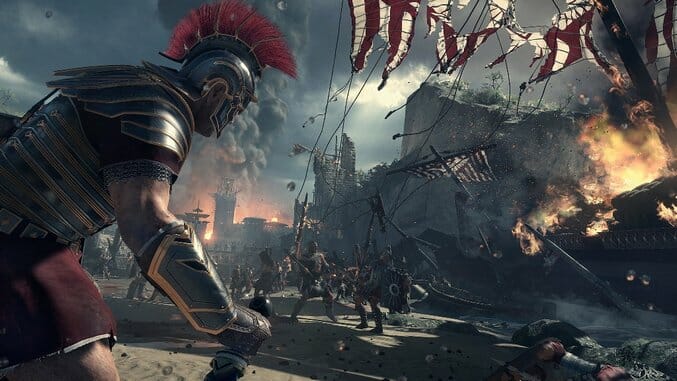Ryse: Son of Rome (Xbox One)

Ryse: Son of Rome is beautiful, but it isn’t pretty. Of all the games for the new consoles, this Xbox One exclusive looks the most like what you’d expect a “next generation” game to look like. Its Roman backdrops and misty British vistas look like photorealistic paintings. You can almost see the English actors behind the animation when characters chat in cutscenes. And when you’re playing the game, it all gets buried in blood and body parts. It’s the most impressive example on consoles of the type of realistic graphics usually found in serious games about serious men getting seriously killed.
You don’t just look at games, though. When you play Ryse, the entire notion of generational advancement collapses around you. Ryse is ten hours of tapping one button to block, tapping a second to stab, and occasionally tapping a third once every ten minutes or so to roll away from giant hammers that can’t be blocked. Ryse is nothing but combat, and its barebones combat system barely changes from start to finish. The game looks like 2014, but its action is ancient.
That’s not inherently a failure, though. Sometimes you just want to mindlessly mash buttons as impossibly skilled centurions hack their way to Scotland on your behalf. Marius, your avatar, spins from one barbarian to the next, raising his shield or swinging his sword in time with your button presses, often taking on up to a half-dozen foes at a time. This swordplay, both brutal and acrobatic, can be a real-life stress reliever, with a grace similar to the balletic fisticuffs of an Arkham game, but bloodier and slightly diminished in scope. It’s efficient, if repetitive.
There are stylistic variations at times. Marius can throw a pilum, which requires aiming with the left trigger while firing with the right. There are a few sections where he hops behind scorpio arrow guns, a low-tech version of the turrets that regularly pop up in almost every modern day military shooter. Along with his cohort he will occasionally form a testudo, the “turtle” formation that lets a legion slog towards archers without any exposed skin. You’ll encounter each of these scenarios once or twice during a mission, of which there are eight in total, and although they break up the monotony of butchering men, and perfectly fit the Roman milieu, they’re basically afterthoughts, slight digressions from the rhythms of hacking and slashing.
Ryse is singularly focused on chopping through limbs and puncturing throats and generally painting the screen with blood. It prioritizes “executions”—when you weaken an enemy enough, a skull will appear about its head, at which point you can enter an execution quick time event for extra experience and a health boost. There are even double executions, where you slay two men at once. Their bodies will turn a color corresponding to a button—yellow for Y, blue for X—and the quicker you hit that button the greater the bonus you get. You don’t have to hit any button at all, though—Marius will still execute his man, you just won’t get as much in return. It’s weird to link health regeneration to killing another man, but it adds a slight element of strategy to the game—if you’re surrounded and low on health, you’ll want to focus on one guy until you can execute him and get that health boost.







































